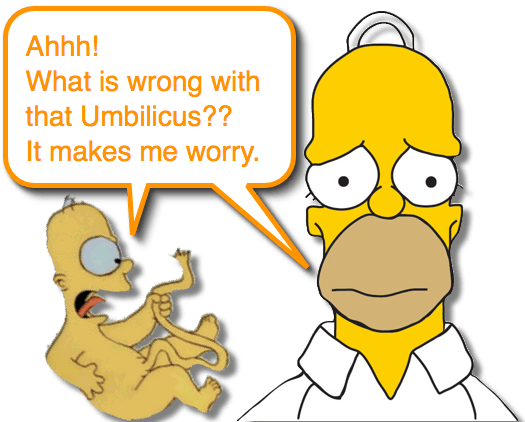Umbilical Granuloma

 It is easy to fall into a potentially callous mindset in the Emergency Department – “If it isn’t an emergency, then it can wait to see the Primary.” While that may be a valid statement, it won’t win you any bed-side manner awards. It also mandates the ability to determine what presentations are not due to underlying emergent issues, which can be tricky in kids (hence the common theme of remaining vigilant).
It is easy to fall into a potentially callous mindset in the Emergency Department – “If it isn’t an emergency, then it can wait to see the Primary.” While that may be a valid statement, it won’t win you any bed-side manner awards. It also mandates the ability to determine what presentations are not due to underlying emergent issues, which can be tricky in kids (hence the common theme of remaining vigilant).
Additionally, if the family brings their kid at 3am, they likely think it is at least important enough to warrant your potential concern. Fortunately, many times the “important” issue revolves around a typical oddity of being a young child (like periodic breathing). Being comfortable with some minor issues, particularly neonatal issues (currently, there are 26 categorized neonatal Morsels), can make you more comfortable with dealing with the potential emergent conditions that exist within seemingly innocuous presentations. Umbilical Granuloma is a good example.
Umbilical Cord Basics
- In utero, the umbilical cord is one of the most important structures. After birth, it becomes useless.
- All of the structures associated with it should be obliterated or recede.
- When they don’t, problems can occur.
- Umbilical Cord Stump may remain attached from 3 to 45 days.
- Mean duration was ~2 weeks.
- Delayed cord separation is associated with some immune problems.
- The care for the umbilical stump vary from institution to institution.
- Some recommend no care.
- Some recommend soaps or alcohol application.
- All fear umbilical stump infection (omphalitis)!
Umbilical Granuloma
- Most common cause of Umbilical Masses.
- Form within the 1st week after cord separation.
- They:
- are moist and pink
- range in size from 1 mm to 10 mm.
- can be associated with some sanguinous or even greenish discharge.
- Most often treated, successfully, with Silver Nitrate application.
- Silver nitrate is not without its complications.
- Some advocate for application of salt crystals instead.
Silver Nitrate
- Silver Nitrate can act as an antiseptic, an astringent, or a caustic agent (depends on the concentration)
- While it can help resolve an Umbilical Granuloma, it can also burn the tissue around it!
- Contact with normal tissue should be avoided.
- The Umbilical Granuloma should be dried before application to limit the potential spread of the silver nitrate by the discharge from the Umbilical Granuloma.
- When dealing with a persistent Umbilical Granuloma:
- don’t just keep adding silver nitrate.
- If the Umbilical Granuloma persists after 2 applications, consider other potential issues.
Other Umbilical Cord Issues
- Omphalitis
- The issue we all worry about.
- Can complicate the other issues as well.
- This is an emergency!
- Omphalomesenteric Remnants
- The Omphalomesnteric Duct (OMD), also known as the vitelline duct, is present in early gestation.
- The OMD connects the yolk sac with the developing GI tract.
- It should involute at week 8 or 9 of gestation.
- Remnants occur in ~2% of the population.
- May persist as tissue attached to ileum = Meckel’s Diverticulum
- May present with painless rectal bleeding.
- Most common of these anomalies.
- May persist as a cyst beneath the umbilicus = OMD Cyst
- May persist as a patent Fistula between the GI tract an umbilicus.
- Present as persistent drainage, often with fecal material!
- May persist as a Polyp at the umbilicus = Umbilical Polyp
- Present as a Very Red mass within the umbilicus.
- Can contain gastric or intestinal tissue.
- Do not resolve with silver nitrate.
- Often confused with Umbilical Granuloma!
- May persist as tissue attached to ileum = Meckel’s Diverticulum
- Urachal Remnants
- Fistula – present with clear drainage or drainage of urine from the umbilicus.
- Cyst – present with painful mass between the suprapubic region and the umbilicus.
- Both can become infected.
What to Do?
- Look for signs of infection (obviously). If infected, do sepsis work up and consult surgery!
- If it appears as if you are dealing with a simple Umbilical Granuloma, gently and carefully apply silver nitrate and arrange follow-up.
- Refer to Surgery:
- If the Umbilical Granuloma / mass did not respond to silver nitrate.
- If it is unusually RED.
- If there is significant drainage.
- If there is a mass associated.


What is the concentration silver nitrate used in umbilical granuloma to be prepared
Good question… and to be honest, I have never really paid attention to the concentration as the hospitals I’ve been at all seem to have the same Silver Nitrate sticks in a tube… and when I look that up online I see – “Silver nitrate applicators are firm wooden sticks with 75% silver nitrate and 25% potassium nitrate.”
Don’t overdo it!
Thank you,
sean